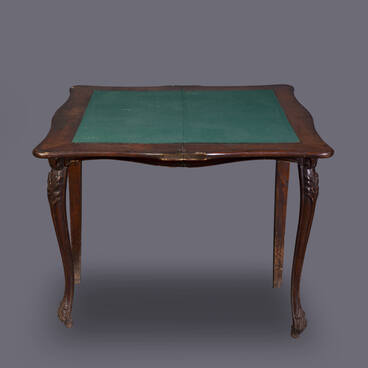The term “floor clocks” appeared in England and referred to all the models that were placed on the floor. The first floor clocks appeared in the 17th century and were called “clock cabinets”. Originally, they were low, with short pendulums that had an oscillation amplitude of 80 to 100°. The antique clocks could lag by 10 to 11 minutes over a 24-hour period. The invention of the anchor escapement in 1670 reduced the amplitude of the oscillation to 4–6° and made it possible to use longer pendulums. The new clocks, with their unusually long and narrow case, used much less energy; their parts showed less wear and tear from friction, and the clocks were thus much better in terms of rate, longevity and accuracy. A century later, the cases for floor clocks began to be made of expensive wood, in a variety of sizes and shapes. In the 18th and 19th centuries, clocks could be as tall as 2.7 meters.
The Museum of Local Lore displays a mechanical floor clock in a rectangular wooden case. The case consists of two parts, with the upper part taking up about a quarter of it. The front panel of the upper part is a rectangular door with a round glazed window. Inside is a clock mechanism with a dial. The dial is round and made of yellow metal, the Arabic numerals are black, and the hands are made of black metal. The upper part closes with a hook located on the left wall. Above is a figured finial featuring a bowl with a bunch of grapes and branches with leaves at the sides. The front panel of the lower part was also designed as a door with a rectangular glazed window, closed with two hooks located on the left wall.
Behind the glass there is a pendulum made of yellow metal on a wooden handle and two massive yellow metal weights on chains. The clock strikes every 30 minutes. The case is mounted on four legs, the front ones are ball-shaped and the rear ones are made of metal. The clock dates from the last quarter of the 19th century. The pendulum clocks were highly accurate and so served as the basic standard of time for households and businesses until the beginning of the 20th century.
The Museum of Local Lore displays a mechanical floor clock in a rectangular wooden case. The case consists of two parts, with the upper part taking up about a quarter of it. The front panel of the upper part is a rectangular door with a round glazed window. Inside is a clock mechanism with a dial. The dial is round and made of yellow metal, the Arabic numerals are black, and the hands are made of black metal. The upper part closes with a hook located on the left wall. Above is a figured finial featuring a bowl with a bunch of grapes and branches with leaves at the sides. The front panel of the lower part was also designed as a door with a rectangular glazed window, closed with two hooks located on the left wall.
Behind the glass there is a pendulum made of yellow metal on a wooden handle and two massive yellow metal weights on chains. The clock strikes every 30 minutes. The case is mounted on four legs, the front ones are ball-shaped and the rear ones are made of metal. The clock dates from the last quarter of the 19th century. The pendulum clocks were highly accurate and so served as the basic standard of time for households and businesses until the beginning of the 20th century.



